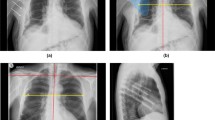Abstract
Background
Current decision algorithms involving surgical stabilization of rib fractures (SSRF) do not consider either specific fracture locations or other chest wall bony injuries. Our objective was to characterize the impact of scapula fractures on morbidity among patients who underwent fixation of sub-scapular rib fractures. We hypothesized that an ipsilateral scapula fracture was associated with poor acute and long-term outcomes.
Methods
Retrospective review of two institutions’ prospectively maintained SSRF databases (October 2010 to January 2019). Patients who underwent repair of ≥ 1 sub-scapular rib fracture were included. Patients were grouped by the presence of an ipsilateral scapula fracture. Outcomes were acute SSRF complications, long-term rib implant removal, and quality of life via phone survey.
Results
A total of 144 patients were analyzed; 53 (36.8%) had an ipsilateral scapula fracture. Patients with a scapula fracture had a higher injury severity score (p = 0.02), degree of pulmonary contusion (p < 0.01), and RibScore (p < 0.01). The overall incidence of both acute re-operation (n = 4, 2.8%) and long-term implant removal (n = 5, 3.8%) following SSRF was low and did not vary by the presence of a scapula fracture. Only twenty-one patients completed phone questionnaires a median of 38 months after SSRF; both shoulder and rib outcomes were excellent and did not vary by the presence of a scapula fracture.
Conclusion
Ipsilateral scapula fractures are common in patients who undergo surgical stabilization of sub-scapular rib fractures. Despite higher injury severity, patients with an ipsilateral scapula fracture did not incur worse outcomes.

Similar content being viewed by others
Availability of data and material
Not applicable.
Code availability
Not applicable.
References
Zehr M, Klar N, Malthaner RA (2015) Risk Score for predicting mortality in flail chest. Ann Thorac Surg 100(1):223–228
Pieracci FM, Majercik S, Ali-Osman F, Ang D, Doben A, Edwards JG et al (2017) Consensus statement: surgical stabilization of rib fractures rib fracture colloquium clinical practice guidelines. Injury 48(2):307–321
Pieracci FM, Leasia K, Bauman Z, Eriksson EA, Lottenberg L, Majercik S et al (2020) A multicenter, prospective, controlled clinical trial of surgical stabilization of rib fractures in patients with severe, nonflail fracture patterns (chest wall injury society NONFLAIL). J Trauma Acute Care Surg 88(2):249–257
Voleti PB, Namdari S, Mehta S (2012) Fractures of the scapula. Adv Orthop 2012:903850
Cole PA, Freeman G, Dubin JR (2013) Scapula fractures. Curr Rev Musculoskelet Med 6(1):79–87
Dimitroulias A, Molinero KG, Krenk DE, Muffly MT, Altman DT, Altman GT (2011) Outcomes of nonoperatively treated displaced scapular body fractures. Clin Orthop Relat Res 469(5):1459–1465
Jones CB, Sietsema DL (2011) Analysis of operative versus nonoperative treatment of displaced scapular fractures. Clin Orthop Relat Res 469(12):3379–3389
Tyburski JG, Collinge JD, Wilson RF, Eachempati SR (1999) Pulmonary contusions: quantifying the lesions on chest X-ray films and the factors affecting prognosis. J Trauma 46(5):833–838
Chapman BC, Herbert B, Rodil M, Salotto J, Stovall RT, Biffl W et al (2016) RibScore: A novel radiographic score based on fracture pattern that predicts pneumonia, respiratory failure, and tracheostomy. J Trauma Acute Care Surg 80(1):95–101
Pieracci FM, Rodil M, Stovall RT, Johnson JL, Biffl WL, Mauffrey C et al (2015) Surgical stabilization of severe rib fractures. J Trauma Acute Care Surg 78(4):883–887
Thiels CA, Aho JM, Naik ND, Zielinski MD, Schiller HJ, Morris DS et al (2016) Infected hardware after surgical stabilization of rib fractures: outcomes and management experience. J Trauma Acute Care Surg 80(5):819–823
Sarani B, Allen R, Pieracci FM, Doben A, Eriksson EA, Bauman ZM et al (2019) Characteristics of hardware failure in patients undergoing surgical stabilization of rib fractures: a chest wall injury society multicenter study. J Trauma Acute Care Surg 87:1277–1281
Tatro JM, Schroder LK, Molitor BA, Parker ED, Cole PA (2019) Injury mechanism, epidemiology, and Hospital trends of scapula fractures: a 10-year retrospective study of the National Trauma Data Bank. Injury 50(2):376–381
Pieracci FM, Johnson JL, Stoval RT, Jurkovich GJ (2015) Completely thoracoscopic intra-pleural reduction and fixation of severe rib fractures. Trauma Case Rep 1:39–43
Bottlang M, Walleser S, Noll M, Honold S, Madey SM, Fitzpatrick D et al (2010) Biomechanical rationale and evaluation of an implant system for rib fracture fixation. Eur J Trauma Emerg Surg 36(5):417–426
Funding
Not applicable.
Author information
Authors and Affiliations
Corresponding author
Ethics declarations
Conflict of interest
The authors declare that they have no conflict of interest.
Additional information
Publisher's Note
Springer Nature remains neutral with regard to jurisdictional claims in published maps and institutional affiliations.
Electronic supplementary material
Below is the link to the electronic supplementary material.
Rights and permissions
About this article
Cite this article
Gargur Assuncao, A., Leasia, K., White, T. et al. Characterization and influence of ipsilateral scapula fractures among patients who undergo surgical stabilization of sub-scapular rib fractures. Eur J Orthop Surg Traumatol 31, 429–434 (2021). https://doi.org/10.1007/s00590-020-02789-x
Received:
Accepted:
Published:
Issue Date:
DOI: https://doi.org/10.1007/s00590-020-02789-x




